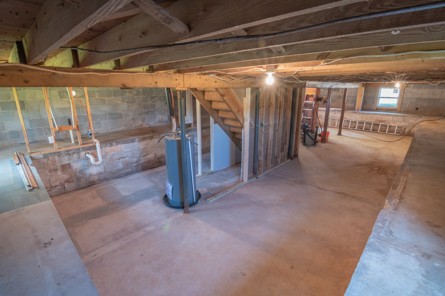Every home needs a furnace to create warm air, especially during freezing seasons. But a major concern for many homeowners is where to install the furnace in the house.
While most furnaces are installed in the basement, closet, or garage, some homes don’t have a basement or enough space in these locations to accommodate their furnace. So, most times we recommend installing a furnace in an attic as an excellent alternative, especially if you want to save space.
There are many other benefits to installing an attic furnace. However, there are also drawbacks that you should consider before making any decisions.
So, let’s go over the pros and cons so you can make an informed choice.
Furnace In Attic – Pros and Cons
Before you go on to install your furnace in the attic, it’s a good idea to invite an HVAC expert to inspect your home.
They will determine if there’s easy access to your roof and enough space to accommodate furnace installation. Once confirmed to be perfect, you can then go on to put your furnace in the attic while enjoying the following benefits.
Pros
Easy Installation
As HVAC professionals, we often recommend installing attic furnaces because of the ease of installation. Although, this will depend on the size and condition of your attic.
A wide and well-conditioned attic allows the HVAC professional to move around easily during installation and maintenance. And most modern homes are built with larger attics to allow HVAC installation.
Also, installing a furnace in the attic is usually easier than in the basement or garage. Rather than squeeze the furnace in a tight space in a basement, the attic provides you with enough space to install your furnace whichever way you want. Whether horizontally or vertically, depending on the shape of the attic.
Saves Space
The luxury of space isn’t something common in many modern homes. Every part of the home needs to be used judiciously. Hence, installing a furnace in the garage or closet may not be a good idea because of other storage needs.
On the other hand, the attic, which is mostly forgotten and unused, can provide enough space for furnace installation, thus helping you save more storage space in your garage and closet.
Saves money
The cost of buying HVAC systems is already high enough to strain your budget. And you want to save as much cost as possible on installation, maintenance, and repairs. An attic furnace costs less to install than installing it in other locations of your home.
By installing your furnace in the attic, there’s less duct work as the venting can go directly through the roof rather than breaking walls or remodeling your garage and closet. Also, the roof gives easy access for inspection, maintenance, and repair of the attic furnace, thus saving you costs.
Quieter Environment
A furnace can be noisy and disturbing when the unit is operating. By installing your furnace in the attic, you can reduce the effect of its sound and create a completely quiet environment.
Safer In Flood-affected Area
If your home is located in a flood zone, there’s no debate on whether to put your furnace in the attic or not; the attic is simply your only choice. Installing your furnace on the roof provides safety for your unit during heavy rainfall, thus reducing the risk of damage to the unit.
Even Distribution of Heat
As long as your attic furnace is professionally installed, you can expect to enjoy a more even distribution of heat throughout your home.
Cons
Lower Efficiency
Although people argue that this is only a problem when the attic is small and unconditioned. Installing a furnace in a poorly insulated attic can reduce its energy efficiency.
This is because the attic is usually too hot and lacks enough air for the effective functioning of the furnace. Perhaps this is one of the reasons why the basement is a common location for HVAC installation; it is usually colder and allows the furnace to work effortlessly.
Increased Energy Consumption
Another problem with installing a furnace in the attic is the direction of airflow. Naturally, hot air wants to go up; but when the furnace is installed in the attic, it has to force the warm air in a downward direction through the duct into your home.
This causes the furnace to work harder to circulate air throughout your home, leading to increased energy consumption and rising electricity bill.
Increased Chance of Damage to the Unit
The rising hot air in the attic can also heat the furnace materials, leading to wear and tear, holes and leaks in the ductwork. As the holes in the ductwork get bigger, so does the damage to the entire furnace system. Also, because attics are always hot, there’s a higher risk of damage to your furnace than when installed in the basement.
It’s Harder to Detect a Fault
Because the attic is not a space we visit often, it is usually difficult to detect holes and leaks in the ductwork until it becomes severe, leading to a higher repair cost. An easier way to prevent this would be to ensure regular inspection and maintenance of the furnace by an HVAC professional.
Factors to Consider When Installing Furnace in Attic
Although the attic furnace installation would be done by your HVAC contractor, it is still a good idea to know the basic factors to consider before installing a furnace in the attic. Perhaps this can help you be more confident that you’re making the right choice.
Installation Area
An attic area is very crucial to your furnace installation because it accommodates the gas or electric furnace and determines its effective functionality.
The installation area must be broad enough and well-conditioned to accommodate the HVAC system or furnace material. And an attic furnace requires a route with minimum specifications of 30 inches high, a maximum length of 20 feet, and 22 inches in width.
Type of Furnace
Choosing a gas or an electric furnace is a matter of preference. Both can perfectly go into the attic without any problem, provided it is professionally installed.
The important thing is to ensure that local and international mechanical codes are followed when installing a furnace into your attic. As such, venting and alarm systems must be available, and the gas furnace must fit nicely in an attic area to ensure that any gas leaks are detected quickly when they occur.
Cost
The cost of purchasing, installing, and maintaining a furnace in an attic varies greatly depending on whether it is gas or electric.
While an electric furnace is less expensive to install, annual maintenance may cost around $2,500. Whereas a gas furnace is more expensive to install, it is less expensive to maintain, costing only about $1500 per year.
New or Old Furnace
Another factor to consider is whether you are installing a new furnace in your attic or transferring an existing furnace to your attic. In this case, the layout of your place of residence, the height and length of your attic, and the climate in your area will all influence whether an attic furnace is the best option for you.
Need Professional Help?
Installing a furnace requires specialized knowledge and skills. Unless you know what you’re doing, you shouldn’t attempt this job on your own. Instead, contact a professional who specializes in this area.
At Hurliman Heating, we offer affordable air conditioner and furnace installation services and go above and beyond to ensure that your new furnace will work properly. Contact us today to learn more!





